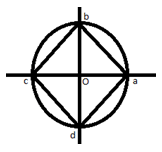This set of Complex Analysis Multiple Choice Questions & Answers (MCQs) focuses on “Roots of Complex Numbers.
1. The nth roots of any number are in ____________
a) arithmetic progression
b) geometric progression
c) harmonic progression
d) no specific pattern
View Answer
Explanation: We know that reiα=rei(α+2π). Hence, if reiα/n is a nth root of a number, then, re i(α/n+2π/n) is also a nth root of that number. Hence, the roots are in G.P. with common ratio= ei2π/n.
2. In the Argand Plane shown below, a,b,c,d are the 4-th roots of 16. Find the area of the closed Polygon having a,b,c,d as its vertices.

a) 2 sq. units
b) 4 sq. units
c) 8 sq. units
d) 16 sq. units
View Answer
Explanation: The complex numbers a,b,c,d are in G.P. with common ratio eiπ/2. Therefore, a square is formed having side of 81/2(since O-a length is 2, therefore, b-a length is 81/2) . Hence the required area=(81/2)2=8 sq. units.
3. For k=1,2,…9, if we define zk=cos(3kπ/10)+isin(2kπ/10), then is it true that for each zk, there exists zj satisfying zk× zj=1?
a) True
b) False
View Answer
Explanation: zk= ei(2kπ/10)⇒ zk× zj=ei(2π/10)(k+j), zk is 10th root of unity.
⇒\(\overline{z_k}\) is also 10th root of unity. Taking zj as \(\overline{z_k}\), we have zk×zj=1.
4. For k=1,2,…9, if we define zk=cos(3kπ/10)+isin(2kπ/10), then is it possible that z1×z=zk has no Solution z?
a) True
b) False
View Answer
Explanation: z=zk/z1=ei(2kπ/10-2π/10)=eiπ/5(k-1)
For k = 2; z=eiπ/5, therefore a solution always exists.
5. Find the value of the expression (-1/2+i√3/2)637+(-1/2-i√3/2)337.
a) -1
b) 0
c) 1
d) i
View Answer
Explanation: (-1/2+i√3/2)=ω and (-1/2-i√3/2)=ω2, ω being the complex cube root of unity.
Therefore, expression has the value ω637+ω337=ω+ω2=-1.
6. Let a and b be complex cube roots of unity. If x=7a+2b and y=2a+7b, then evaluate xy.
a) 9
b) 39
c) 45
d) 53
View Answer
Explanation: Write a=ω and b=ω2.
Now, xy=(7a+2b)(2a+7b)=(7ω+2ω2)(2ω+7ω2)=14ω2+14ω+53=39 (since, 1+ω+ω2=0).
7. For integral x,y,z, find the range of |x+yω+zω2| if it is not true that x=y=z.
a) [1, ∞)
b) [√3, ∞)
c) (0, √3)
d) (0, ∞)
View Answer
Explanation: Put a=∞ and b=c=0 to show that maximum value tends to infinity.
Now, z=|x+yω+zω2|, hence, z2=|x+yω+zω2|2=(x2+y2+z2-xy-yz-zx)=1/2{(x-y)2+(y-z)2+(z-x)2}
Now if x=y, then y≠z and x≠z (given that x,y,z are not all equal)⇒(y-z)2≥1, also (z-x)2≥1 and
(x-y)2=0. Therefore, z2≥½(0+1+1)=1, hence |z|≥1.
8. Find the value of (1+ω)(1+ω2)(1+ω4)(1+ω8)…to 2n factors.
a) 1
b) 2
c) 3
d) 4
View Answer
Explanation: (1+ω)(1+ω2)(1+ω4)(1+ω8)…up to 2n factors
= (-ω2)(-ω)(1+ω)(1+ω2) …up to 2n factors
= 1×1×1×L up to n factors = 1.
9. If α,β,ȣ are the roots of equation x3–3x2+3x+7=0 and ω is cube root of unity, then evaluate
(α-1)/(β-1)+(β-1)/(ȣ-1)+(ȣ-1)/(α-1).
a) ω
b) ω2
c) 3ω
d) 3ω2
View Answer
Explanation: equation can be simplified to (x-1)3=-8⇒(x-1)/(-2)=(1)1/3⇒roots: 1,ω,ω2
⇒ α=-1, β=1-2ω, ȣ=1-2ω2. Therefore, required value=-2/(-2ω)+(-2ω)/(-2ω2)+(-2ω2)/(-2)
= 1/ω+1/ω+1/ω=3/ω=3ω2.
10. Find the possible value(s) of Re(i1/2)+|Im(i1/2)|.
a) -1, 1
b) 0, √2
c) 0, 1
d) 1, √2
View Answer
Explanation: We can write: i=eiπ/2⇒i1/2=eiπ/4=1/√2+i/√2, also i1/2=ei3π/4=-1/√2-i/√2
Hence, Re(i1/2)+|Im(i1/2)|=1/√2+1/√2=√2 OR -1/√2+1/√2=0.
11. Let ω and ω2 be the non-real cube roots of unity and 1/(a+ω)+1/(b+ω)+1/(c+ω)=2ω2 and 1/(a+ω2)+1/(b+ω2)+1/(c+ω2)=2ω, then calculate 1/(a+1)+1/(b+1)+1/(c+1).
a) 1
b) 2
c) 3
d) 4
View Answer
Explanation: Given relations can be written as: 1/(a+ω)+1/(b+ω)+1/(c+ω)=2/ω, and
1/(a+ω2)+1/(b+ω2)+1/(c+ω2)=2/ω2⇒ω and ω2 are roots of 1/(a+x)+1/(b+x)+1/(c+x)=2/x.
⇒[3x2+2(a+b+c)x+bc+ca+ab]/[(a+x)(b+x)(c+x)]=2/x⇒x3+(bc+ca+ab)x-2abc=0.
Let 3rd root be α (apart from ω and ω2). Then, α+ ω+ ω2=coefficient of x2=0⇒α=1. Hence, 1/(a+1)+1/(b+1)+1/(c+1)=2/1=2.
12. Find the cube root of 8i lying in the first quadrant of the complex plane.
a) i-√3
b) 2i+√3
c) i+2√3
d) i+√3
View Answer
Explanation: Let z3=8i⇒z3=-8i3⇒[z/(-2i)]3=1.
⇒z/(-2i)=1 or ω or ω2⇒z=-2i or -2iω or -2iω2
⇒z=-2i or i+√3 or i-√3 out of which i+√3 lies in the first quadrant.
13. If ω is the complex cube root of unity, then which among the following is a factor of the polynomial x6+ 4x5+3x4+2x3+x+1?
a) x+ω
b) x+ω2
c) (x+ω)(x+ω2)
d) (x–ω)(x–ω2)
View Answer
Explanation: Let f(x)=x6+ 4x5+3x4+2x3+x+1. Therefore, f(ω)= ω6+4ω5+3ω4+2ω3+ω+1=0
Since, ω2 is the complex conjugate of ω, therefore ω2 is also a root (roots occur in conjugate pairs). Therefore (x–ω)(x–ω2) is a root. Also, f(-ω)=(-ω)6+4(-ω)5+3(-ω)4+2(-ω)3+(-ω)+1=1-4ω2+3ω-2-ω+1≠0⇒-ω and hence -ω2 are not the roots.
14. Find ∑r=1(ar+b) ωr-1 if ω is a complex nth root of unity.
a) n(n+1)a/2
b) nb/(1-n)
c) na/(ω-1)
d) n(n+1)a/(ω-1)
View Answer
Explanation: (a+b)+(2a+b)ω+(3a+b)ω2+…+(na+b)ωn-1=b(1+ω+ω2+….+ωn-1)+a(1+2ω+3ω2+…+nωn-1)
Let S=1+2ω+3ω2+…+nωn-1⇒Sω= ω+2ω2+…+(n-1)ωn-1+nωn⇒S(1-ω)=1+ω+ ω2+…+ωn-1–nωn=-n
⇒S=n/(ω-1)⇒E=na/(ω-1).
15. Which of the following is not equal to (-1)1/3?
a) -1
b) (-√3+i)/(2i)
c) (√3+i)/(2i)
d) (√3–i)/(2i)
View Answer
Explanation: Let x=(-1)1/3⇒x3=-1⇒(-x)3=1⇒-x=1, ω, ω2
Therefore, x=-1,- ω,- ω2=-1, (-√3+i)/(2i), (√3+i)/(2i).
Sanfoundry Global Education & Learning Series – Complex Analysis.
To practice all areas of Complex Analysis, here is complete set of 1000+ Multiple Choice Questions and Answers.
If you find a mistake in question / option / answer, kindly take a screenshot and email to [email protected]
- Apply for 1st Year Engineering Internship
- Practice Probability and Statistics MCQ
- Practice Numerical Methods MCQ
- Check Engineering Mathematics Books
